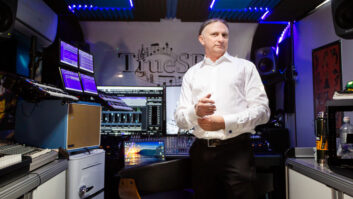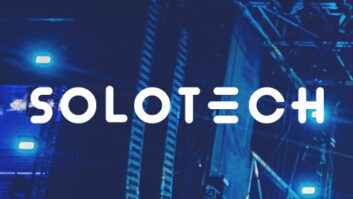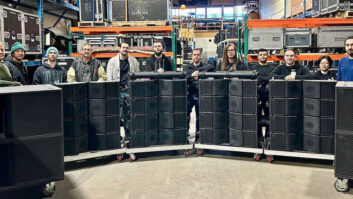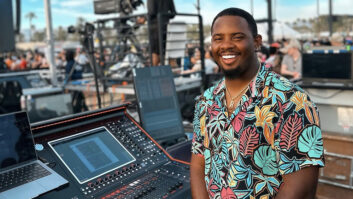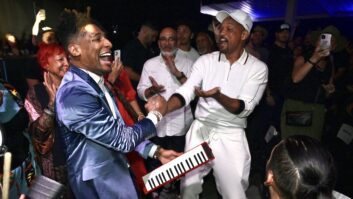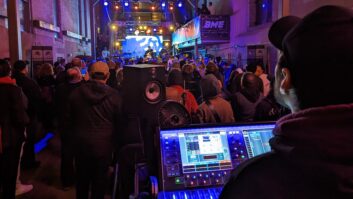Tame Impala performs at Bonnaroo. Springboard Productions broadcasted live performances from the festival this past year. Photo by Dave Vann
“I first webcast a music festival in August 2005 at the inaugural Lollapalooza Chicago,” says Hank Neuberger, Grammy-winning founder of Springboard Productions. “The promoter called and said, ‘We’re starting a festival in Chicago; we’re calling it Lollapalooza, and one of our sponsors, AT&T, would like to webcast it. Do you know how to do that?’ I took a deep breath and said, ‘sure.’”

It may have been a daunting challenge for Neuberger, but it was hardly a leap in the dark. A recording engineer and producer with decades of experience, he is currently executive vice president of Glenwood Place Studios in Burbank, CA and Chicago Recording Company. Neuberger has also been broadcast audio supervisor for the annual Grammy Awards telecast since 1987, sharing the production’s Emmy Award for Outstanding Sound Mixing the year it made the transition to 5.1 audio. In 2003, he formed Third Wave Productions, producing downloadable music videos and concert footage for online exhibition, before taking that phone call in 2005.
This year, Springboard will hit its highest peak to date: “We did live webcasting from five of the most prominent, largest American festivals,” he reports. Beginning in March, Springboard handled audio and video webcasting for Coachella in the Southern California desert, Bonnaroo in Tennessee in June, Lollapalooza in Chicago in August and, one week later, Outside Lands in San Francisco, and in October will be at Austin City Limits in Texas.
Although Springboard provided webcasting services for only the first weekend of Coachella, which is now a two-weekend festival, and will do the same for the ACL Music Festival, he reports, “We provide video services including support for the IMAG screens and recording for the other weekends.” There is only one camera crew, “so we are shooting all the bands for the promoter on the stages where they have IMAG screens, and that program goes up on the screens.”
He adds, “One of the really rewarding parts of working with the leading promoters is that they entrust my crew and me with the look and feel of their wonderful creations. Not just for the webcast audience, but also for the fans on the ground at these festivals who, today, with the size of some of these shows, are frequently experiencing this through the image on the screen as well as the audio off the stage.”
Each of the major U.S. festivals has its own unique culture, says Neuberger, and each of the promoters is also unique. Consequently, the resources that Springboard must assemble for each festival varies, based on the number of stages to be covered, the number of performances being webcast, how many IMAG screens are required and the operational hours of the event. “Some of the city festivals are done by 10:00 at night,” he says. “Bonnaroo is 4 or 5 a.m.” On a show like Coachella, for example, “We have a crew that’s over 100 people—cameras, utilities, main truck engineering and audio people.”
On the video production side, he elaborates, “Cameras are at multiple stages, but we home-run those cameras back to a central video world location, where we typically have an A truck, an HD video truck. Our go-to vendor is NEP Trio, who has done virtually all of these festivals with us. We’ve developed this system together, relying on their great engineering.”
Indeed, NEP’s Trio Video not only provided engineering support at Coachella and the Stagecoach country music festival that follows a week later on the same site in Indio, CA, but also at Lollapalooza Chile in Santiago earlier in April. Trio Video provided technical support, design and equipment coordination to Springboard Productions and promoter C3 Presents for the two-day, six-stage South American festival. Lollapalooza Chile featured headliners Pearl Jam, Queens of the Stone Age, The Black Keys and DeadMau5.
This year’s two-weekend Coachella Festival was Trio Video’s seventh year as the show’s mobile video production facilities and services provider. Two of the company’s production trucks, Rhythm and Blues, supported 18 cameras feeding the three simultaneous HD video channels. Those cameras also fed the large-format stage screens—supplied and operated by NEP Screenworks, Trio Video’s sister organization—as well as a stream to the VIP enclosure on the festival grounds.
Typically on a multi-stream festival, explains Neuberger, “We have a director per stage and we set up each director on a sub-switcher. Each director’s sub-switcher feeds our main video truck, where our webcast director is populating our multi-channel webcast with the live video from the stages, sometimes just slightly time-shifted, plus the interviews, bumpers and other interstitial content that we have to keep that stream full of contemporaneous content throughout the day.”
Hank Neuberger, Founder of Springboard Productions
That extra material may be produced by Springboard or by the promoter. “Some promoters have their own ENG [electronic news gathering] crews collecting on-location interviews. At Coachella, we have great interview teams out doing on-location interviews with artists and fans, and we edit those on-site and get them into the webcast within hours.”

Audio for the streams may be produced using remote trucks—Chris Sheperd’s American Mobile Studio and Guy Charbonneau’s Le Mobile are two long-time Springboard partners—or flypack systems. Most importantly, notes Neuberger, “Ideally, we have multitrack audio at every stage. Not all artists will give us multitrack audio. Some artists prefer that we use their front of house audio, but I still believe that front of house audio is mixed in a different way than broadcast audio to make it most flattering to the artist, so we always hope the artists will let our mixers mix it.”
As he points out, “The needs of that window on a laptop, or a living room TV, are different from being 150 feet from the stage under an open sky. So I prefer to have our mixers do it, but we will always defer to an artist if they tell us they would prefer to have us use their front of house audio. There may be good reasons for that—they have elaborate effects, they have things that they feel that only they can deliver and they may have a great mix—and that’s fine. So it’s not always the case, but we have multitrack at as many stages as we can.”
Apart from offering Springboard’s engineer a better opportunity to produce a webcast-optimized stream, multitrack audio is also typically archived. As it turns out, that workflow proved very beneficial at a recent festival.
“We were at the recent Outside Lands Festival; Paul McCartney performed on the Friday night. His management said they would only allow us to play him in our webcast on Sunday night if they first approved of our audio remix. So, Friday night, when Paul finished, we remixed it, sent it to management, and they sent us back approval to webcast part of the set, which we did on Sunday.
“We were very pleased and flattered with that. For me and for my mixer, Chris Sheperd, to sit there at the console mixing Paul McCartney, singing songs we’ve all known for decades, that was a once-in-a-lifetime turn on!”
The number of simultaneous channels that will be webcast is another critical factor governing the resources that must be marshaled at any festival, of course. In 2010, Coachella partnered with Wrigley 5 Gum, which offered remote viewers a branded webcast that could be viewed via Facebook and Myspace. The channel line-up included Jay-Z, Them Crooked Vultures, LCD Soundsystem and The Dead Weather, among many others. Viewers could select from two live streams of music plus a third channel of artist interviews and sights and sounds from around the festival.
“That was the first year that we did a three-channel webcast,” says Neuberger. “And we’ve continued to do three simultaneous channels from Coachella since, which we think is really notable.”
Indeed, the following year, Daniel Terdiman of cnet.com was inspired to write—with a touch of hyperbole—that the 2011 Coachella webcast through YouTube “changed the world.” “This was likely the most complex and sophisticated live concert stream ever and indeed, the 2011 Coachella Webcast may be the most visceral evidence yet that the democratization of music has arrived,” wrote Terdiman.
The writer also quoted the reaction to the webcast by Rob Sheridan, creative director for Nine Inch Nails. “It felt so much more significant and cooler than anything like this that I’ve seen,” said Sheridan. They “really nailed it [and] I can see that this is where things are going.”
Available through the festival’s YouTube channel, the three-day, three-stream 2011 webcast attracted over four million channel views worldwide. Post-festival views were also impressive. Mumford & Sons clocked 134,000 views the week following the festival, and there were already 14,000 views within hours of The National videos posting to the archive. “Generally, we like to have a VOD gallery after the fact,” says Neuberger.
“Offering people multiple online channels has a number of benefits,” he continues. “First of all, we can showcase more artists. But it also gives the viewer a lot more to pick from, and it gives the sponsor increased average engagement times.”
During SXSW 2013, Springboard pushed the channel-count even further, in a branding collaboration with Taco Bell and Twitter. Springboard produced a seven-channel HD webcast of Passion Pit performing at the festival for “Feed the Beat,” Taco Bell’s campaign to connect fans and bands, designing and executing a solution for streaming six wireless “fan-cams” that were operated by selected bloggers and tastemakers in addition to Springboard’s six-camera professional team.
In late August, Taco Bell released a documentary directed by Sam Jones of RSA Films that features performances by Passion Pit and up-and-comers Wildcat! Wildcat! that includes live footage and fan-made content from SXSW. In the lead up to the SXSW show on March 11, Twitter users were encouraged to post tweets and images for potential inclusion in the documentary.
The 2011 Coachella webcast offered viewers worldwide access to more than 60 artists, including such major names as Kanye West, Arcade Fire, Duran Duran and the Strokes. The web interface also offered engagement via social media through connections with Twitter and Facebook, displaying a feed of comments on the current performances or, often as not, expectation of upcoming appearances.
The same three-stage stream was also available on Facebook, although access was a little more convoluted (involving liking and sharing, among other steps). Wrigley also saw some benefit from its sponsorship, reportedly adding 100,000 fans to its Facebook page.
YouTube was not exactly at the forefront of the streaming live music revolution, which began to take off around 2008, but it has quickly caught up. Shows by U2 from the Rose Bowl in Pasadena, CA in 2009 and Arcade Fire from New York’s Madison Square Garden the following year, both via YouTube, certainly racked up plenty of views—10 million and 4.5 million live streams respectively.
YouTube has become a significant partner for Springboard, according to Neuberger. “Whether it’s YouTube, Ustream or others, we have pioneered the delivery of these events to these platforms, where we’re no longer using satellite uplinks.”
Following the typical broadcast television paradigm, Neuberger certainly used uplinks to begin with, but their limitations became apparent. “Uplinks are susceptible to weather interruptions, and that burned us a number of times in 2012, so we were compelled to find a better way.” Anyone who attended or watched Lollapalooza Chicago 2012 will recall the delays caused by the severe thunderstorms.
“We really have got an extremely high quality transmission unit that Springboard’s Tech Services division has put together to deliver high quality, multi-channel webcast data to the entry points of the platform’s CDN [content distribution network], both primary and backups, on multiple transmission paths,” he continues. “So we have instant failover should anything occur, whether it’s power failure or data path interruption. We have multiple levels of redundancy that we couldn’t afford when we were constrained by the satellite uplink standard.”
Not that Springboard distributes only to the web. The company has also produced broadcast specials from various festivals for a number of promoters. Prior to getting into webcasting, says Neuberger, “I used to record shows at Bonnaroo—jamband shows that the festival would then offer for sale after the festival, back in 2003, 2004.”
But with the proliferation of cable networks, and perhaps a resurgence of interest in music television in the wake of MTV’s abdication of that role, “there have been a number of specials about festivals, on HDNet or Fuse or Palladia, that we were involved in, that we delivered on behalf of festivals. And just this year, for the 2013 Stagecoach country music festival, we delivered live performances directly to AXS TV.”
Neuberger has worked closely with artists throughout his career, and that has allowed his company to offer clients another unique service. “One of the things that distinguishes Springboard from some other production companies is that we typically handle all the artist clearances. So we’re doing the outreach on behalf of the promoter to artist management, to encourage their participation in the webcast, to get it on paper, so that everybody’s clear on the participation.
“That’s something I’m personally involved with and, wherever appropriate, use my relationships from having been in the industry for a long, long time. We’ve built up some trust, where they know that the quality of what we do will be flattering to the artists.”
Trent Reznor of Nine Inch Nails is one such example. “Trent was going to perform at the Coachella Festival in April this year with his other band, How to Destroy Angels. They reached out to us through the festival to say they wanted to participate in the webcast. Trent wanted to talk to us; he had a very visual presentation built for this act, and he was very interested in showing it to us in advance and making sure he was able to give us some direction in how he wanted it shot.”
What was interesting, says Neuberger, was what prompted Reznor to reach out. “The reason he was so enthused about showcasing this band in the Coachella webcast is that he had really and specifically enjoyed being at home during Coachella 2012 and watching our webcast all weekend. He had ported it from his computer to the big screens in his house and thought it looked fantastic. He was so enthused that when he was performing at Coachella, he wanted to be part of the webcast, and knew that we could deliver what he had in his imagination.”
Hundreds of thousands of fans make the trek to the major U.S. festivals annually, to be sure, but that’s a drop in the bucket compared to the numbers who can view the webcast. That’s a win-win for fans and bands; the former get to see performers that they otherwise might not see, and the artists can perform to an audience far larger than could even be contained by the festival grounds.
“Talent buyers of these festivals are like the record labels of old,” observes Neuberger. “They go out and they find and showcase emerging talent before anyone.”
Everybody experiences these events differently, he says, “But it’s all about engagement. Clearly, the festivals, in general, are very popular. They are a value buy for the fans. The greatest ones, the ones that I had the privilege of working this year—Bonnaroo, Coachella, Lollapalooza, Outside Lands, Austin City Limits—are tremendous cultural jewels. These are special places, and the artists know it and feel it and enjoy it.”

